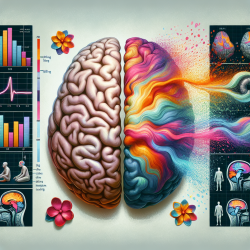In the realm of stroke rehabilitation, understanding the intricacies of brain changes post-stroke is crucial for developing effective therapeutic strategies. A recent study titled "The effect of time since stroke, gender, age, and lesion size on thalamus volume in chronic stroke: a pilot study" offers valuable insights into how various factors influence thalamus volume in chronic stroke patients. This research not only sheds light on the complexities of brain recovery but also encourages practitioners to delve deeper into the subject for improved rehabilitation outcomes.
Key Findings from the Study
The study analyzed MRI data from 69 chronic stroke participants to investigate how factors such as time since stroke, gender, age, and lesion size affect thalamus volume. Here are some pivotal findings:
- Ipsi-lesional vs. Contra-lesional Thalamus: The ipsi-lesional thalamus (the side of the brain affected by the stroke) was found to be significantly smaller than the contra-lesional thalamus (the opposite side). This highlights the impact of stroke on brain symmetry and function.
- Influence of Age and Intracortical Volume: Both age and intracortical volume were significant factors affecting thalamus volume. As expected, aging was associated with a decrease in thalamic volume, aligning with previous research on age-related brain changes.
- Lesion Size Impact: Larger lesion sizes were linked to a decrease in ipsi-lesional thalamus volume, emphasizing the importance of lesion characteristics in understanding post-stroke brain alterations.
Implications for Practitioners
The findings from this study have several implications for practitioners working in stroke rehabilitation:
- Personalized Rehabilitation Plans: Understanding that factors like age and lesion size significantly affect thalamus volume can help tailor rehabilitation plans to individual patients' needs. This personalized approach could enhance recovery outcomes by addressing specific neural deficits.
- Focus on Neuroplasticity: The study underscores the importance of neuroplasticity—the brain's ability to reorganize itself—in stroke recovery. Practitioners should focus on therapies that promote neuroplasticity to maximize functional recovery.
- Further Research Encouraged: Given the cross-sectional nature of this study, additional longitudinal research is necessary to fully understand the long-term impacts of these factors on thalamus volume and overall recovery. Practitioners are encouraged to contribute to or engage with ongoing research efforts.
The Path Forward
This pilot study provides a foundational understanding of how demographic and clinical factors influence thalamus volume in chronic stroke patients. However, it also highlights the need for further investigation into neural circuitry changes post-stroke. By expanding our knowledge through continued research, we can refine rehabilitation strategies and improve patient outcomes.
To read the original research paper, please follow this link: The effect of time since stroke, gender, age, and lesion size on thalamus volume in chronic stroke: a pilot study.










